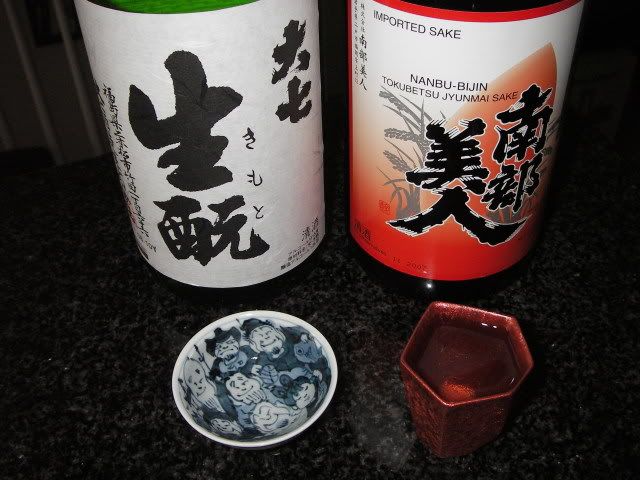
Daishichi Honjozo Kimoto from Fukushima Prefecture. Made from Gohyakumangoku rice. Semaibuai 69%, SMV +1, acidity 1.3, 15.5% abv. Opened at room temperature at the Rieslingfest on Friday, where I didn't really take notes. Sampled at length over the weekend though, also at room temperature. This is the sibling of the Daishichi Junmai Kimoto that J. opened for me in Kyoto a couple of weeks ago. Expressive nose, what one might expect from honjozo, but maybe it’s the kimoto expressing – shellac, rice pudding, jasmine, lots of cinnamon. On the palate, light and clean, surprisingly dry. Light bodied, sitting a bit up front. To my palate, less sweet than the Junmai version. Creamy, a very faint earthiness, some nuttiness as well. More cinnamon. So clean, Daishichi’s kimoto are really just outstanding, very impressed.
Nanbu Bijin Tokubetsu Junmai from Iwate Prefecture. Made from Gin Otome rice, semaibuai 55%, SMV +5, acidity 1.5, #9 yeast, 15.5% abv. Pretty, light nose of Yubari melon (like a richer cantaloupe), white flowers, and rice husks. A restrained, junmai nose. On the palate, medium+ body, viscous, round, with light sweetness. Cool sensation, melon and pear juices. Fully chilled, the acidity only pokes through on the finish, as the sweetness fades, revealing a refreshingly bitter bite. As this warms, the acidity grows – however, at room temperature itself, the alcohol becomes a bit pronounced, so I think the ideal temperature for this is very lightly chilled.
Tuesday, March 31, 2009
Daishichi and Nanbu Bijin [1 Koku - 89]
Labels:
Aruten,
Junmai-shu,
One Koku
Subscribe to:
Post Comments (Atom)




No comments:
Post a Comment